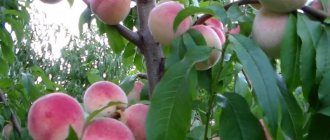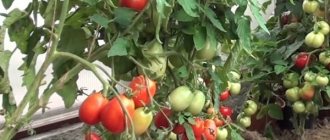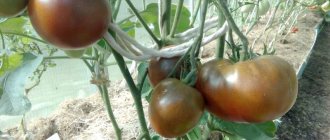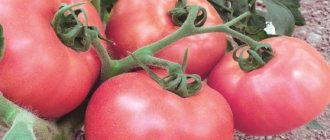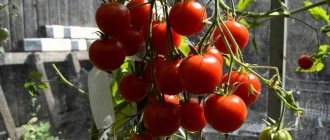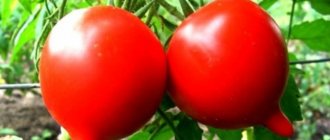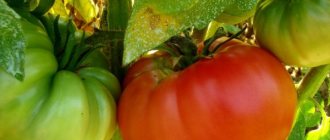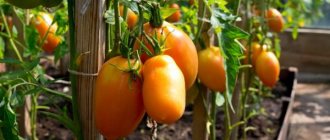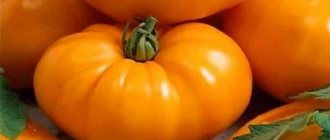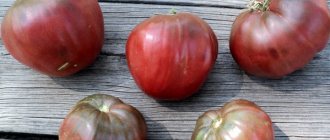Vegetable growing » Tomatoes
1
2016
Article rating
Kira Stoletova
The Kapia rosea tomato is one of the most common varieties of tomato vegetables. Experts have included it in the top ten best types of tomatoes. This is a universal species that can be grown in all regions, with any climatic conditions. As soon as the summer season begins, gardeners ardently buy up all the seeds of this variety.
Description of tomato Capia rosea
Characteristics and description of the variety
Thanks to the work of Russian breeders, the Kapiya pink tomato variety was born, which in 1997 was included in the State Register of Breeding Achievements. More than 20 years have passed since then, but tomatoes are still in high demand among gardeners.
Distinctive features
Determinate type, but height can reach 2 m or more. The bush is powerful and densely leafy, the leaves are elongated and dark green. In regions with a short and cool summer season, the crop is grown in greenhouse conditions; in the southern zone, the tomato takes root well in open ground.
The height of the main stem indicates that the plant must be staked, otherwise, despite its power, the bush will not support the weight of the fruit-bearing branches.
Due to the numerous lateral shoots, the plants are regularly planted, thereby eliminating the density of the plantings.
The ripening period is average: 110–115 days pass from the emergence of seedlings to the start of fruiting.
Productivity is high: 1 seedling bears up to 4 kg of fruit when no more than 3 plants are placed per 1 m2.
The variety is distinguished by its stable immunity to the main tomato diseases, such as tobacco mosaic, fusarium and verticillium.
Fruit characteristics
The average weight of tomatoes is 140–160 g, the shape is cylindrical, elongated. The appearance resembles a large drop of water. The color is deep pink, the taste is sweet with a subtle sourness. The pulp is dense, juicy, the peel is strong and not prone to cracking, so ripe vegetables can be successfully frozen. It is believed that when frozen, tomatoes retain the greatest amount of vitamins.
The use of vegetables is universal: they are excellent for preparing fresh dishes and for canning for the winter. Tomatoes are also processed into juices, pastes, adjika and lecho.
Durable skin allows ripe vegetables to maintain their presentation for a long time and transport them over any distance.
The photo shows Kapija rosea tomatoes.
Growing rules
First of all, it is recommended to plant the seeds. Greenhouses are used for this. Seeds are planted 45-60 days before planting in open ground conditions. After the seedlings are ready for planting, you should begin choosing the soil. Firstly, it must contain a minimum amount of acids and alkalis. Secondly, it is important that it is located in open areas where sunlight will flow without problems.
Planting in open ground is carried out at the moment when the soil warms up to a temperature of 16°C. It is also recommended to loosen the soil so that a sufficient amount of oxygen penetrates into it. It is necessary to remove all weeds and other foreign objects so as not to block the development of the root system. If you live in the southern region, then planting can be done in early May. If your region of residence is the northern part of the country, then it is better to wait until June.
When planting, you should maintain a distance of 50-60 cm. But between the holes it should be about 40 cm. The planting depth is 2 cm, so that the seedlings form faster and accelerate their growth. There should be no more than 4 plants per 1 m2.
How to grow seedlings
2 months before planting in the ground, sowing of seeds begins. Proper preparation for this will not only increase the germination rate, but also strengthen the immune system.
Seed preparation
First, empty copies are separated from full ones. To do this, prepare a saline solution by dissolving 1 teaspoon of salt in a glass of water and place the grains in it for 10 minutes. Those that float to the surface are disposed of, as they will not sprout.
Then the seeds are disinfected in a weak solution of potassium permanganate for 20 minutes. Disinfection of planting material protects plants from fungal damage for a long time. After disinfection, the seeds are washed with running water.
Germination on damp gauze increases the germination rate. The fabric is slightly moistened with warm, settled water and the seeds are laid out on it. Afterwards they are removed to a warm and dark place with a temperature of +28°C. After 2-3 days, small sprouts will appear. This indicates that the seeds are ready to be planted in the ground.
Reference ! Since the culture does not belong to a hybrid, the seed fund retains its parental properties in subsequent generations.
Container and soil
The planting container is treated with a dark manganese solution and small drainage holes are made at the bottom of each container, necessary for the outflow of moisture. When fluid stagnates, the risk of fungal infections increases.
You can plant in a common wooden box or in separate containers. It is easiest to transport seedlings in plastic cups to summer cottages, and when grown in peat pots they will require minimal care.
Reference ! Peat pots in the walls contain many nutrients that seedlings receive during growth and development.
The soil is prepared from garden soil, peat, humus and river sand in equal proportions. The resulting mixture, like the planting containers, is disinfected with a strong solution of manganese.
Sowing
Seeds are planted to a depth of 1.5 cm with a distance of 3 cm from each other. Using a spray bottle, lightly moisten with warm, settled water and cover with film. This creates a greenhouse effect for faster germination of seed material. The containers are left in a room with a temperature of +24 °C.
Reference ! If the seeds are planted on the surface, they will germinate along with the shell, which will slow down further growth.
Seedling care
When seedlings appear, the containers are placed on the windowsill. Plants need light for 13 hours. If there is a shortage of it, the seedlings will stretch out and weaken. To prevent this, install additional lighting in the form of fluorescent lamps.
Water as the top soil layer dries out with warm, settled water from a shallow watering can. Afterwards the soil is slightly loosened.
To ensure that the sprouts are even, without tilting, they are turned to the light in different directions.
When 2 true leaves appear, the seedlings are picked and planted in separate containers. Afterwards, increased growth of lateral roots occurs, which contributes to further intensive development of plants.
Before planting in the ground, the seedlings are hardened off so that they quickly get used to the new conditions. This is done outdoors at an average temperature of +17 °C. First, the containers are left outside for 1 hour, gradually increasing the time to 10 hours.
Kapia Rosea is a variety of tomato plant.
Variety characteristics:
Properties of the Kapiya Pink variety:
Recommended region on the map:
Information on the admission of Tomato Kapija Pink from the Register of the State Variety Commission of the Russian Federation
Application for admission No. 47665, registered 2007-04-23. The Tomato variety Kapiya Pink was included in the register of those approved in 2008. Approved for use in the regions: Northern, Northwestern, Central, Volga-Vyatka, Central Black Earth, North Caucasus, Middle Volga.
The originators of the Kapiya Pink Tomato variety are:
Other varieties of tomato plant
Search for variety by name
Variety selection
Question to the portal experts
If you haven't found the answer to a question, don't hesitate to ask an expert.
Register or Login so you don't have to enter your Name and Email every time
Thanks for the comment! It will be published after checking by a moderator!
No comments yet, be the first!
A portal for those who love their dacha
Your question has been sent for moderation. Don't worry, we quickly check your questions and your question will be answered within 1 day.
We have noticed that you are already registered on our website. We recommend that you log in to view the question you created. If you don't remember your password, you can recover it.
You were not registered until today, so we have registered you. Your password has been sent to your specified mailbox.
Help our site develop!
Please read this message, it will not take up much of your time!
We so need your comments and questions to understand in which direction we should develop.
Don't forget to leave a comment if you found what you were looking for. And if you haven’t found it, use the “Ask an Expert” form in the site header. We will answer this question, and other visitors will be able to find the information that you could not find.
Sincerely, team of the portal Dacha-Dacha.ru
Your question has been sent for moderation. Don't worry, we quickly check your questions and your question will be answered within 1 day.
We have noticed that you are already registered on our website. We recommend that you log in to view the question you created. If you don't remember your password, you can recover it.
You were not registered until today, so we have registered you. Your password has been sent to your specified mailbox.
How to grow tomatoes
After 2 months, after the soil has warmed up, the seedlings are sent into the ground. The beds are chosen in a sunny, unshaded place without drafts. If there is insufficient lighting, you will not get a rich harvest.
Landing
The holes are prepared in advance with a distance of 50–60 cm from each other. The seedlings are buried to the first leaves, the soil is compacted and watered with warm, settled water. After this, the young bushes are left to get used to the new place without watering or feeding.
Further care
As soon as the young seedlings take root, establish regular watering at least 2 times a week. Use only warm, settled water, since overcooling can cause the root system to rot. In addition, cold water has a negative effect on developing ovaries. Large barrels exposed to the sun are suitable for heating.
Drip irrigation is installed in greenhouses. With such an irrigation system, the root system is always fed only with warm water, and the humidity level does not exceed the norm.
After watering, the soil must be loosened, ensuring air permeability of the soil. Weeds are removed with roots. Weeds extract a lot of useful substances from the ground and serve as a breeding ground for infections.
Reference ! Mulching beds helps retain moisture longer and serves as a preventive measure against pests. Straw is most often used as mulch.
For fertilizing, a full complex of minerals or organic matter is used. Mullein infusion, bird droppings and weed infusion are suitable for tomatoes. The crop also responds well to the addition of wood ash.
During flowering, a full complex of minerals with a predominant content of phosphorus is added, and at the time of fruiting, potassium salts are added so that the fruits ripen faster.
Important ! Organic compounds are used only in low concentration: 1:15. Highly concentrated solutions can cause burns to the root system.
Features of cultivation and possible difficulties
According to gardeners, seedlings achieve the highest yield when plants are formed into 2 stems. One stepson is left above the first flower brush, all the rest are removed. If this is not done, the bush will waste nutrients on the growth of unnecessary branches, and the fruits will form small and dull in color.
They plant the crop early in the morning so that the cut areas have time to heal by the evening. To prevent germs from getting into the wounds, they are treated with a weak solution of manganese.
To form an even and powerful trunk, a wooden or metal support is installed next to each seedling, to which the stem is tied almost immediately after transplantation. As they grow, fruitful branches are also fixed to the support so that they do not break under their own weight.
For fixation, in addition to vertical supports, a trellis is used. To do this, install metal rods on two opposite sides of the beds and stretch a wire horizontally between them. The stem and branches of the bush are fixed to it with soft tapes. This method of gartering is considered less traumatic.
Diseases and pests
The culture has such strong immunity against viral and fungal diseases that it does not even require regular preventive measures. This does not mean that you need to forget about loosening, mulching, hilling and regular watering. When carrying out all these mandatory actions, it is not necessary to additionally spray with antifungal agents.
When transplanting, experienced gardeners treat the seedlings with a weak solution of manganese so that they do not get sick while all their efforts are focused on adapting to new conditions.
The whitefly butterfly is the most dangerous pest for the Pink Capia . Harm is caused not only by adults, but also by their larvae. To combat insects, plants are sprayed with an infusion of onion peels, sharp-smelling herbs (marigolds, calendula) are planted next to the tomatoes and pheromone traps are installed. When there is a large concentration of the pest, the insecticides “Confidor” or “Aktara” are used.
Reference ! Pheromone traps can be purchased at any specialty store.
Features of cultivation
Tomatoes are capricious crops. To reap a good harvest, you need to follow the growing technology. First of all, preparations should be made:
- Preparation of planting material. For sowing, you should choose only high-quality seeds. In addition, they need to be tested for germination. To do this, the seeds should be poured into a container with salted water for 2 hours. The seeds that sink to the bottom are complete. They can be used for sowing. Instances that rise to the surface should be removed.
- Soil preparation. Tomatoes prefer to grow in fertile soil. It is advisable to purchase soil in a specialized store.
- Preparing containers. You can select any containers for growing seedlings. The main thing is that they have a drainage hole.
Important! Since seedlings have a negative attitude towards picking, it is advisable to plant the seeds in peat cups.
The process of sowing seeds is simple. The boxes need to be filled with earth, the seeds distributed, and sprinkled with soil. Cover the top of the crops with glass and place the containers in a warm place.
Breeding in greenhouses and open ground
Planting in a checkerboard pattern is convenient not only in the greenhouse, but also in open beds. Plants do not shade each other and are well ventilated, which reduces the risk of infections.
It is recommended to ventilate closed structures every day so that the temperature and humidity do not increase. With standard indicators, infections will not develop. Fresh air destroys the usual habitat of greenhouse pests: for example, spider mites.
When growing tall, the top of the plant is pinched, and the seedlings spend nutrients on the developing ovaries, and not on further growth.
When propagated in greenhouse conditions, drip irrigation is used. Place a plastic bottle without a bottom in the root zone and fill it with water. The fact is that the crop only needs warm water, due to which the humidity and temperature in the greenhouse will constantly increase. This can trigger the development of a fungal infection that will quickly spread to all plants.
If potatoes or peppers are planted next to a tomato plant, it is necessary to regularly carry out preventive maintenance on all plants. These crops belong to the same family and suffer from the same diseases. Potato diseases can spread to tomatoes, and vice versa. Therefore, in such a neighborhood, regular preventive measures are mandatory.
Cultivation care
Caring for the Kapia rosea variety is standard. The main care activities are as follows: watering, fertilizing, weeding, loosening the soil, tying and pinching.
- Watering. Plants need to be watered regularly. To do this, it is advisable to use warm water. Watering must be of high quality and timely.
- Loosening the soil and removing weeds. Weeds have a detrimental effect on plants, so you need to get rid of them as they appear. Loosening the soil is also a mandatory procedure; as a result, air will flow to the root system.
- Feeding. Plants must be fed with organic and mineral fertilizers. To do this, it is worth using humus, manure, wood ash, phosphate and nitrogen compounds.
Note! Timely application of fertilizers will increase the yield several times.
Harvesting and application
The ripening of the fruits is uniform; they are cut in whole clusters. Ripe vegetables do not overload the bush, as they are distributed evenly. Tomatoes have good keeping quality and can withstand long-term transportation. Therefore, the variety is popular among farmers.
The use of vegetables is universal. All kinds of fresh dishes and winter preparations are obtained from them. Tomatoes do not crack during heat treatment, therefore they are suitable for preservation. Fruits have nutritional value when frozen, as they retain most of the vitamins.
Also, delicious juices are obtained from ripe vegetables, not only canned, but also freshly squeezed. For a more saturated color, pink tomatoes are mixed with red ones.
Recommendations and opinions of vegetable growers
Those who planted and grew Kapiya rosea tomatoes leave positive reviews about the taste of the fruit, the possibilities of processing, canning and fresh freezing.
Antonina Kozlova, 52 years old, Saratov:
“I purchased the variety Kapija rosea in a specialized store
The teardrop shape of the pink tomatoes caught my attention. Grown through seedlings
The seeds are 100% similar. Until it warms up, the seedlings are kept indoors on the windowsill, and after the end of the frost period, I transplant them into a greenhouse. After this, I transfer the seedlings to open ground. During the season, the bushes grow up to 2 m in height, so I make an additional support for the stem, to which I tie the plant using fabric tape. I collect half a bucket of tomatoes from 1 bush per season. I make juice from the fruits and salt the whole fruits. I was pleasantly surprised by the ability to freeze tomatoes.”
Vasily Ilyin, 61 years old, Voskresensk:
“Last season I decided to plant the Kapia rosea variety in the greenhouse. Attention was drawn to the description of the variety and its taste characteristics. The bushes grew very tall and powerful, each with bunches of tomatoes. I would like to note the high yield of tomatoes and the ability to periodically remove fruits from the bush. Tomatoes are pleasant to the taste, very aromatic, pink in color, slightly elongated in shape. I was surprised by the resistance to diseases.”
Advantages and disadvantages
The advantages include the unusual shape of the fruit, which is clearly visible in the photographs. In addition to appearance, the variety has other advantages:
- opportunity to settle down in all regions;
- the ability to form ovaries in any conditions;
- ease of care;
- high productivity;
- immunity to diseases;
- excellent taste;
- long-term storage;
- long-distance transportation.
Disadvantages include regular pinching, mandatory gartering and bush formation.
Tomato Capia pink
photo by Valentina Redko
Description and characteristics of the tomato variety Kapiya pink, reviews, photos
Mid-season, indeterminate, cluster-bearing, productive tomato variety. In the middle zone, it is recommended to grow it in a greenhouse.
The bush is powerful, tall (up to 2 meters), requires gartering and pinching. The best results were obtained when forming a plant with 2 or 3 stems.
Basic qualities of fruits
photo by Valentina Redko
The fruits are pepper-shaped, bright pink in color at maturity, weighing up to 150 grams, excellent taste. These tomatoes are good for pickling and canning, and they are also quite suitable for fresh consumption. Taste quality is 4.
Features of cultivation, planting and care
Sowing the seeds of this variety of tomatoes for seedlings is carried out 60-65 days before the intended planting in the ground. Seedlings dive at the stage of two true leaves. When planting seedlings per 1 sq. per meter of the prepared area, up to 3 plants are placed, when formed into 1 stem - up to 4.
The variety is resistant to major tomato diseases.
The tomato variety Kapiya rosea is included in the State. register for the Russian Federation.
How to tie up tomatoes quickly and easily, video
If you grew Kapia rosea tomatoes, please write whether you liked them or not. What was the yield and taste of the fruits in your climatic conditions? Briefly describe the advantages and disadvantages of this tomato in your opinion. If possible, attach a photo of the entire bush or individual fruits you grew to your comment. Thank you!
Your reviews of the Kapija rosea tomato and additions to the description will help many gardeners evaluate this variety objectively and decide whether it is worth planting or not.
Farmer reviews
Most reviews about the tomato are positive, which indicates its easy care and high-quality products. Here are some opinions:
Evgeniya, Ryazan: “I planted a tomato for the first time, I paid little attention to it, but the seedlings did not suffer from any disease and gave an excellent harvest. The result surprised me so much that I wanted to grow it in the future. The fruits on the bush were even and medium in size. I was especially pleased with the taste. It is original and significantly different from other tomatoes.”
Elena, Saratov: “My seedlings reached 2 m in open ground. The plants have formed powerful and spreading. I didn’t wear my stepson often, I paid most attention to the garter. The vegetables ripened quickly and were very tasty. But they turned out to be even tastier when frozen. Once thawed they are soft and sweet. I’ll definitely plant more for freezing.”
Agrotechnics of cultivation
Sowing seeds for seedlings is carried out 2 months before the planned planting in the ground. Growing planting material requires maintaining temperature conditions, timely watering and fertilizing.
In the phase of formed 2 true leaves, a dive is carried out. For planting seedlings, choose well-lit places. It is recommended to consider crop rotation when choosing a location for tomatoes.
The best predecessors of culture are:
- zucchini;
- cucumbers;
- dill;
- carrot.
Before planting, the soil is loosened, weeds are removed, and organic fertilizer is added to the holes made. The choice of time to plant seedlings and the method of cultivating the variety depends on the climatic conditions of the region.
The plant is intended for cultivation in open ground, but in the northern regions it is better to plant in greenhouses.
High yields are achieved by following the rules of crop care. With the right approach, fresh tomatoes can be enjoyed throughout the entire fruiting period.
Early pink tomatoes
In open areas in cool areas, it is better to plant early forms, which bear fruit 90-100 days after planting. Early pink tomatoes are an excellent choice for both open ground and greenhouses; after winter, many people want to quickly enjoy fresh vegetables from their garden.
June pink
Brought out by US breeders. The fruits are sweet and juicy. Weight reaches 300 g. The shape is smooth and round. The surface is smooth and glossy. Mature bushes are very tall, so they need to be tied up. The yield is 10 kg per 1 m2.
Lights of Moscow
They ripen very quickly, on the 105th day after germination. Suitable for warm climates. The color is rich pink, almost red. Tomatoes have a smooth surface. Perfectly transportable. The weight of one fruit is 110 g. From 1 m2 of plantings, 5 kg of juicy tomatoes are harvested.
Polbig
An early pink tomato for the greenhouse with excellent taste. It can also grow in open ground. 3 months after germination, the first harvest is harvested. The hybrid has high immunity.
The fruits retain their integrity even during transportation. Tomatoes of this pink variety have a good presentation. The yield is average, approximately 4 kg per plant.
Wonder of the earth
The early variety ripens on the 90th day after seed germination. Its fruits have sweet and juicy pulp. The bushes grow 2 meters high. Suitable for whole-fruit preparations. High yield from 12 to 15 kg per 1 m2.
Among tomatoes, most of the new varieties are pink tomatoes. They do not require complex care or a lot of attention. Their fruits are usually large and massive. They have a sweet taste. Many have no sourness at all.
